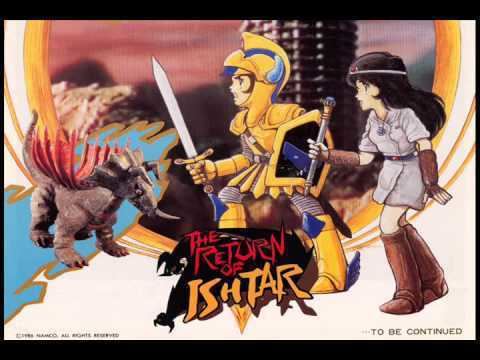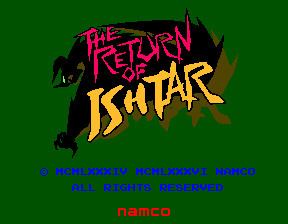Artist(s) Yūichirō Shinozaki | Genre(s) MazeAction RPG Initial release date 1986 Designer Masanobu Endō | |
 | ||
Mode(s) Up to 2 players simultaneously Cabinet Upright, cabaret, and cocktail Publishers Namco, Bandai Namco Entertainment, SPS Similar Babylonian Castle Saga games, Namco games, Action role-playing games | ||
The Return of Ishtar (イシターの復活, Ishitā no Fukkatsu), translating into English as Resurrection of Ishtar, is an action role-playing arcade game - released by Namco in 1986. It runs on Namco System 86 hardware and is the sequel to The Tower of Druaga, which was released two years earlier. It is the second game in the company's Babylonian Castle Saga series, and was later ported to the MSX, NEC PC-8801, FM7, and Sharp X68000 platforms. It was also included in Namco Museum Vol. 4 for the PlayStation.
Contents

Arcade night the return of ishtar
Gameplay

The Return of Ishtar is an adventure game that requires two players; it was also the first game from Namco to have a password feature to give players the opportunity to continue from where they left off (and their first to not feature a scoring system). Player 1 controls the priestess Ki who fights with magic, while Player 2 controls the sword-wielding Prince Gilgamesh - and this sequel game starts off directly after Gilgamesh has saved Ki from Druaga, and focuses on their escape from the tower (and its inhabitants) who are after Gilgamesh and Ki to avenge their former master. There are a total of 128 rooms in the sixty-floor tower, and the screen will only scroll according to Ki's location, so the second player will have to stay close to his partner if he wishes to look around the rooms; Ki attacks by casting spells at the enemies, while Gilgamesh automatically draws his sword whenever an enemy gets close enough to him. However, each time Gil kills an enemy, the numerator of the fraction in the bottom-right corner of the screen (the denominator starts at 15) decreases by a preset amount depending on what enemy type it was - and if it goes down to 0, he will disappear, and the game will be over for both players (which will also happen if Ki is touched by any enemy at all). There are also several different items that can be found in the rooms and collected to aid Gilgamesh and Ki in their quest; the game's designer, Masanobu Endō, also appears unconscious at his desk in the "Dead End" room, but if Ki uses the "Blue Crystal Rod" spell on him, he will wake up, then proceed to warp her and Gilgamesh to the "Calvary Prison" room.



